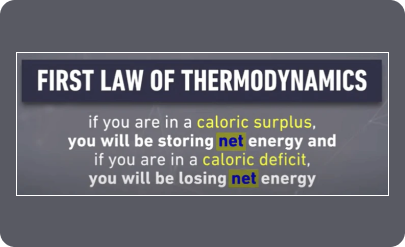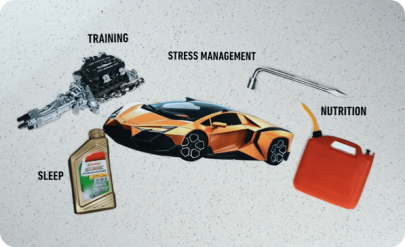It’s quite common to hear people say that you simply can’t build muscle unless you’re in a caloric surplus. In this blog, I’ll explain why this isn’t true and like most things, it’s totally context-dependent.
Before we get into answering the question of whether it’s possible to build muscle in a caloric deficit or lose body fat in a caloric surplus, I’ll ask you to run through a scenario with me.
Let’s imagine a scenario where you have a well-trained lifter who’s never done any direct forearm training and usually maintains his weight with around 2,500 calories. He’s currently running a 12-week cut where he’ll be dieting on 2,000 calories (a 20 percent caloric deficit).
Since he’ll obviously be losing body mass over the next 12 weeks, the question I’m posing to you guys is: If he starts doing direct forearm training with 20 sets per week, will he gain significant muscle in his forearms? Keep in mind, he will be in a net caloric deficit the entire time.
The short answer is YES, unless he’s some kind of non-responder to training or is just really under-eating protein. There’s no good reason to think that he won’t add muscular size to his forearms while losing weight overall.
It seems many people in our community get this concept wrong.
In grasping how it’s possible to build muscle in a caloric deficit or lose body fat in a caloric surplus, the first thing we need to consider is the First Law of Thermodynamics.

The confusion seems to come when people just assume that an anabolic process like building muscle couldn’t happen concurrently with a catabolic process like losing fat.
There are a few ways that we could explain why this assumption is false.
#1
COMMON SENSE APPROACH
Because fat tissue and muscle tissue are separate systems, it’s perfectly possible to lose a bunch of fat due to the caloric deficit while at the same time build muscle from the progressive training stimulus and sufficient protein.
It would be similar to having two different bank accounts where you could withdraw 1,000 bucks from one account, while depositing 50 bucks into the other account. Note how you’d still have withdrawn a net amount of 950 bucks, despite monetary gain in one of the accounts.
#2
MUSCLE MATH
One kilogram (about 2.2 pounds) of muscle contains 1,800 calories, but one kilogram of fat has 9,400 calories. This huge caloric difference between muscle and fat exists because muscle is mostly made up of water that has much less stored energy than fat does.
Let’s imagine someone gained two kilograms (about 4.4 pounds) of muscle across a six-month training program while losing one kilogram of fat. (This scenario is totally reasonable for someone in their first couple years of intelligent training.)
If we do the math, we’ll see that they gained two kilograms of muscle, which equals a gain of 3,600 calories, and then they lost one kilogram of fat, which equals a loss of 9,400 calories. Even though they would have gained one kilogram of total body weight, there must have been a total net energy deficit of 5,800 calories across those six months.
Keep in mind that this is a net total deficit.
Because there are about 180 days in six months, this would only come out to about a 32 calorie deficit per day. Remember that this is despite the fact that over four pounds of muscle were gained.
#3
ACTUAL TRAINING RESEARCH RESULTS
As an example from the research, let’s look at one 2016 study at a Stu Phillip’s Lab. In the following graph, you can see that on average, subjects lost about five kilograms of fat mass while gaining about a kilogram of lean mass.

Take note that this was despite being in a caloric deficit and due to the fact that they were on a progressive resistance training program and eating a high-protein diet.
Not everyone can expect amazing body recomposition as depicted here. As I outlined in my science-explained YouTube video last year on this, the likelihood of any given individual actually building muscle in a caloric deficit depends on several factors.
It’s easier to build muscle in a caloric deficit if you:
- Are a beginner - The less training experience you have, the easier it will be to build muscle in a deficit
- Have a higher starting body fat percentage - The higher your starting body fat percentage, the easier it’ll be because the stored fat can serve as a massive energy source throughout the deficit.
- Don’t crash diet - The smaller the deficit, the better (keep below ~20%)
- Eat a higher protein diet - Keep protein somewhere around 0.8-1 g/lb bodyweight
If you want to make this a reality for you, keep those four factors in mind.
Next, let’s move along to what I consider an even more interesting question: Is it possible to eat in a caloric surplus and still lose body fat?
Once again, let’s just look at the math here. If you were to gain six kilograms of muscle, which is definitely possible over a year as a beginner or an early intermediate, while at the same time losing a kilogram of fat, then by definition you would have had to have a net surplus of 1,400 calories while losing body fat.
It’s important to note that again, that’s a total cumulative caloric surplus. So, if the transformation happened over a year or 365 days, that would actually only be about a four-calorie surplus per day, which is obviously not practical at all.
Because of the differences in energy density between fat and muscle, I think what this ultimately proves is that it’s possible to lose fat while in a caloric surplus if you build a lot of muscle very quickly.
At risk of just confusing things more, I’ll use two examples of differing lifting experience to prove the broader point that body recomposition certainly is possible, and actually expected, under certain circumstances. Because of differences in the energy density of different body tissues, energy balance and body weight changes aren’t always inextricably linked.
People in their first or second years of training can expect to build muscle and lose fat at the same time, as long as their training program is set up properly, they’re eating sufficient protein, and the caloric deficit isn’t too large.
In practice, I’d recommend about a 15-20 percent deficit. Generally, it’s best to focus on compound movements in the 6-15 rep range with progressive strength increases from week to week, or month to month.
For people beyond their first couple years of training, despite the fact that some data does suggest that body recomposition is still possible in more experienced trainees, I still generally recommend discrete cutting and bulking cycles. This seems prudent because after a certain training age, trying to build muscle while in a caloric deficit will most likely result in very quickly diminishing returns. That is, you’ll either most likely get slower gains or as you get even more advanced, you could just be totally spinning your wheels and not really getting much of anywhere with either goal.
Before we end, I’m going to pose the first scenario once again.
We’ve got the same person in the same 20 percent caloric deficit, but this time he’s been training his forearms with 20 sets per week for the last five years leading into his cut. Throughout his cut, will he continue to build muscle in his forearms or will he at best maintain that muscle?
I’ll just leave that one dangling for you to think about. It’ll be fun to discuss that one in the comments, if you decide to weigh in with your thoughts.
A lot of information in this blog came from James Krieger’s research review, which I strongly recommend subscribing to if you haven’t already. See the link below, if interested.

If you’d like a quick review or more insight on this, a summed-up video of this blog is available on my YouTube channel. Again, you can follow the link below.
That’s it for this one, guys. Thank you so much! I’ll look forward to chatting with you here in the next blog.
References:
https://mennohenselmans.com/energy-balance-myths/
https://pubmed.ncbi.nlm.nih.gov/23679146/
https://pubmed.ncbi.nlm.nih.gov/26817506/
Subscribe to James Krieger's Research Review! (Weightology)
https://weightology.net/become-a-member-of-the-weightology-research-review/



